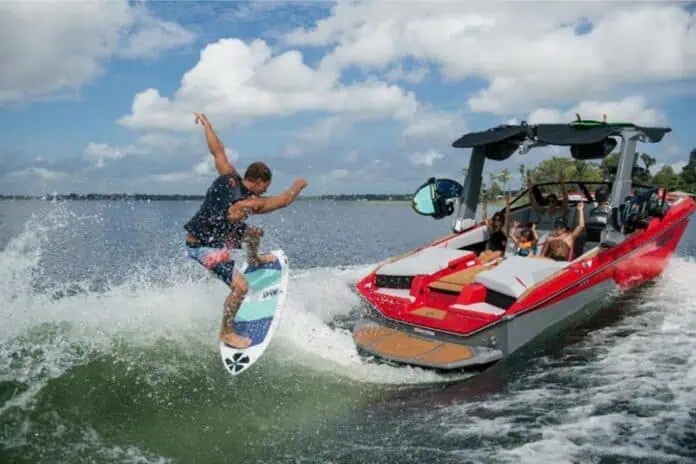Wakesurfing has skyrocketed in popularity over the last decade, offering an adrenaline-pumping yet relatively safe way to enjoy time on the water. Unlike wakeboarding or waterskiing, where you’re directly attached to the boat via a tow rope, wakesurfers ride the boat’s wake at close proximity without being tethered once they find the sweet spot. The boat plays a crucial role in this water sport—not just any boat will suffice.
Choosing the right boat for wakesurfing isn’t only about enhancing the wave; it’s also a matter of safety. Some boats are unsafe for this sport due to their propellers‘ position or inability to generate a proper wake. This article will explore the different types of boats that can safely be used for wakesurfing, analyze their advantages and disadvantages, and cover essential safety tips for towing a wakesurfer. By the end, you’ll clearly understand which boats will give you the best—and safest—experience on the water.
Types of Boats Used for Wakesurfing
Wake Boats (Purpose-Built)
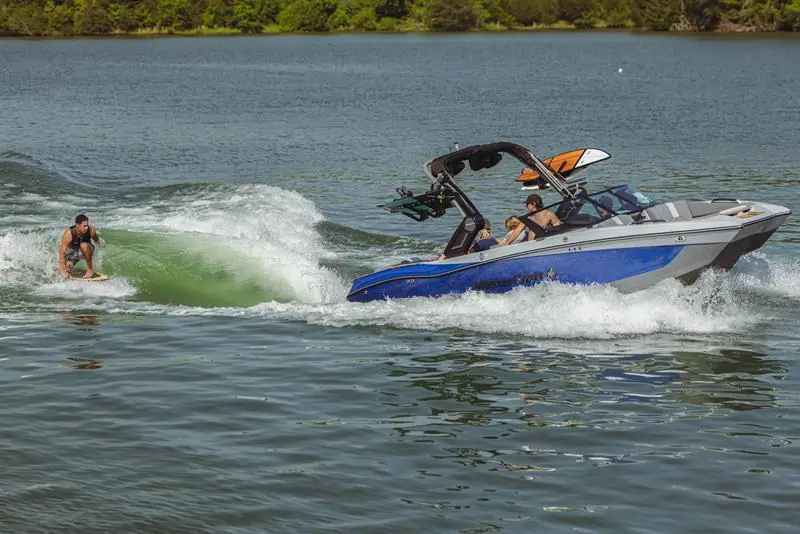
Wake boats are the gold standard for wakesurfing. Designed with wake sports in mind, these boats come equipped with inboard engines, specific hull designs, and advanced features like ballast systems and wake-shaping technology that allow the driver to control the size and shape of the wave. The propeller is tucked under the boat’s hull, making them much safer for wakesurfing.
Popular brands like Malibu, MasterCraft, and Nautique lead the market with models like the Malibu Wakesetter or MasterCraft XStar. These boats are built specifically to create large, surfable wakes. Advanced ballast systems allow precise control over the water’s displacement, creating the desired wave size and curvature. These boats offer surfers a perfect wave every time, which is crucial for beginners and experienced wakesurfers.
Inboard Boats
Inboard boats are a solid alternative to wake boats and are commonly used in wakesurfing. Their engine configuration—where the engine and propeller are housed within the hull—keeps the propeller far away from the surfer, ensuring safety. While these boats might not have the sophisticated ballast systems found on wake boats, they still offer decent wave-making capabilities. Ski boats with inboard engines can be used for wakesurfing if loaded with ballast bags to weigh them down and create a bigger wake.
Many modify their inboard boats by adding aftermarket ballast systems or surf gates to improve the wake. Boats like the Centurion Ri245 or Supra SL offer this combination of safety and wake quality, making them excellent choices for those who might use the boat for multiple watersports, not just wakesurfing.
Surf Boats
Surf boats are explicitly built for wakesurfing, often incorporating advanced surf systems. These systems use tabs or plates that adjust the boat’s wake at the touch of a button. The Axis A24 or the Tige 23ZX are great surf boats with top-of-the-line ballast systems and wake-shaping technology. The most significant difference between surf boats and traditional wake boats is the level of customization. Surf boats allow precise wake adjustments to match the rider’s preferences. Some models even come equipped with GPS systems that automatically adjust the ballast and tabs based on rider profiles.
These boats make wakesurfing accessible to beginners and enjoyable for pros, but their cost reflects this level of sophistication. Surf boats are generally priced at the high end of the market, making them more of a specialized investment.
Outboard Boats
While outboard boats are often cheaper and versatile for many water activities, they are generally not recommended for wakesurfing. The outboard motor’s propeller sits too close to the wakesurfer, making it incredibly dangerous. In addition, outboard boats are not designed to create large enough wakes to allow for optimal wakesurfing.
There are ways to modify outboard boats for wakeboarding or skiing, but wakesurfing remains challenging due to safety concerns. Some users have tried to adapt outboard boats by adding weight to the back, but the wake quality is still subpar, and the safety risks far outweigh any potential benefits.
Personal Watercraft (PWC)
Personal watercraft, like Jet Skis, are commonly seen towing wakeboarders or water skiers, but they are not suitable for wakesurfing. A Jet Ski can produce a small wake, but it’s not large enough for a wakesurfer to ride for an extended period. Moreover, the wake’s size and the PWC’s proximity to the surfer introduce significant risks.
Given their smaller size and lower towing stability, PWCs are more likely to cause accidents when towing wakesurfers. They’re fun for other water sports, but wakesurfing is not one of them.
Advantages and Disadvantages of Each Boat for Wakesurfing Use
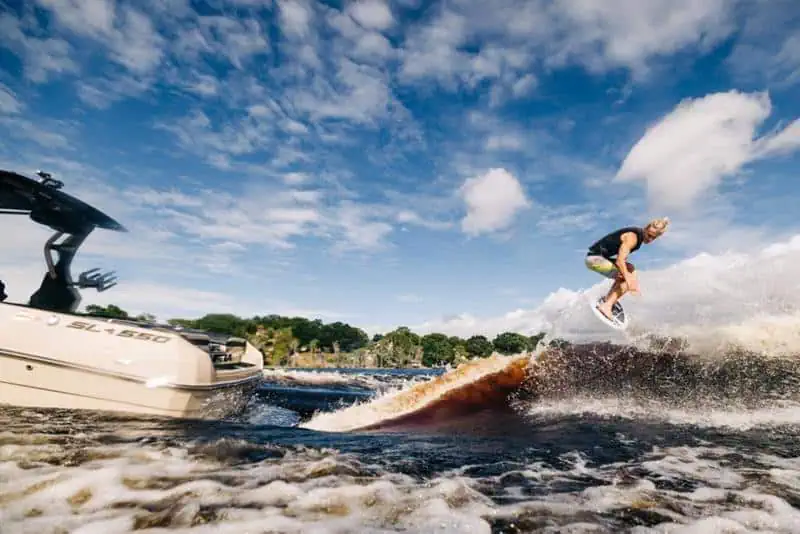
Wake Boats
Advantages:
- Perfect Wave Creation: Wake boats are explicitly built to generate the large, smooth wakes that wakesurfers rely on. Their specialized ballast systems allow users to dial in the ideal wave height, length, and shape for riders of all skill levels.
- Advanced Technology: Wake boats’ inclusion of surf gates, GPS-guided and ballast systems makes them highly customizable. This means you can adjust the wave for different riders, allowing everyone, from beginners to professionals, to enjoy the perfect surf.
- Safety: Inboard engine configuration means the propeller is tucked safely underneath the hull, far from the wakesurfer, eliminating the risk of injury from propeller contact.
- Durability for Watersports: Designed for heavy watersport use, wake boats are more durable than multipurpose boats and can withstand constant use in wakesurfing, wakeboarding, and skiing.
Disadvantages:
- High Cost: Wake boats are among the most expensive on the market, often exceeding $100,000. This makes them a significant investment that may not be within everyone’s budget.
- High Maintenance: Wake boats’ sophisticated systems require regular maintenance. The ballast systems, surf gates, and other technological features need to be kept in top shape, which can add to the cost of ownership.
- Fuel Consumption: Wake boats typically have larger, powerful engines to produce the ideal wake, but this comes at the cost of high fuel consumption, particularly when heavily loaded with ballast.
Inboard Boats
Advantages:
- Safe Propeller Placement: Like wake boats, inboard boats have their propeller housed under the hull, making them safer for wakesurfing than outboard or stern-drive boats.
- Versatility for Multiple Watersports: Inboard boats are often more versatile than dedicated wake boats. While they may not offer the perfect wave for wakesurfing, they can still be used for other watersports like wakeboarding and water skiing, giving you more options on the water.
- Modifiable for Wakesurfing: Many inboard boats can be retrofitted with ballast systems, wake shapers, and other accessories that improve their wakesurfing performance. This makes them a more affordable option for someone who doesn’t want to invest in a purpose-built wake boat.
Disadvantages:
- Less Effective Without Modifications: Out of the box, many inboard boats don’t produce a wake that’s large enough or shaped correctly for wakesurfing. You’ll often need to invest in aftermarket ballast bags or wave-shaping devices to create a decent wake.
- Not as Customizable as Wake Boats: While inboard boats can be modified, they lack the advanced technology that comes standard with most wake boats, such as integrated surf gates and GPS-guided systems that adjust the wake automatically.
Surf Boats
Advantages:
- Best Wave Control: Surf boats have been developed specifically for wakesurfing, and their systems are second to none for creating and controlling the perfect wave. These boats allow you to adjust the wake on the fly, ensuring that every ride is optimized for the surfer.
- High-End Technology: With sophisticated systems like touch-screen controls, automatic ballast adjustments, and even rider profiles, surf boats can create the exact wave characteristics each surfer wants with minimal effort.
- Luxury and Comfort: Surf boats are often built with premium materials and include luxury features such as plush seating, high-end audio systems, and other creature comforts that make spending long days on the water more enjoyable.
Disadvantages:
- Extremely High Cost: Surf boats are among the most expensive on the market, often priced higher than standard wake boats. Their specialized nature and advanced features come at a steep price, limiting them to dedicated wakesurfers with deep pockets.
- Limited Versatility: While surf boats are the best for wakesurfing, they aren’t as versatile for other watersports. Their design and technology specifically aim to create wakes, so they may not perform as well for skiing or tubing.
Outboard Boats
Advantages:
- Affordable and Versatile: Outboard boats are generally cheaper than wake or surf boats and can be used for various activities, from fishing to tubing. They attract people who want a multi-use boat without breaking the bank.
- Easy to Maintain: Outboard engines are easier to access and maintain than inboard engines. Routine tasks like oil changes and motor repairs are much simpler with an outboard configuration, and parts are often less expensive.
Disadvantages:
- Unsafe for Wakesurfing: The location of the propeller on outboard boats makes them inherently unsafe for wakesurfing. The propeller is located right at the back of the boat, where the surfer would be riding, increasing the risk of injury.
- Poor Wake Quality: Outboard boats are not designed to create the large, clean wakes that wakesurfing requires. While they can be used for wakeboarding or waterskiing, wakesurfing is not recommended due to the size and shape of the wake they generate.
Personal Watercraft (PWC)
Advantages:
- Compact and Convenient: PWCs are much smaller than boats, making them easy to transport, store, and launch. They’re also quick and fun for towing activities like tubing or wakeboarding.
- Lower Cost: Compared to larger boats, PWCs are significantly cheaper, making them a budget-friendly option for recreational water sports enthusiasts.
Disadvantages:
- Not Suitable for Wakesurfing: PWCs create small wakes that are not sufficient for wakesurfing. Additionally, their proximity to the surfer poses serious safety risks.
- Stability Issues: PWCs are not designed for towing wakesurfers and can become unstable when maintaining the slow, consistent speed needed for wakesurfing.
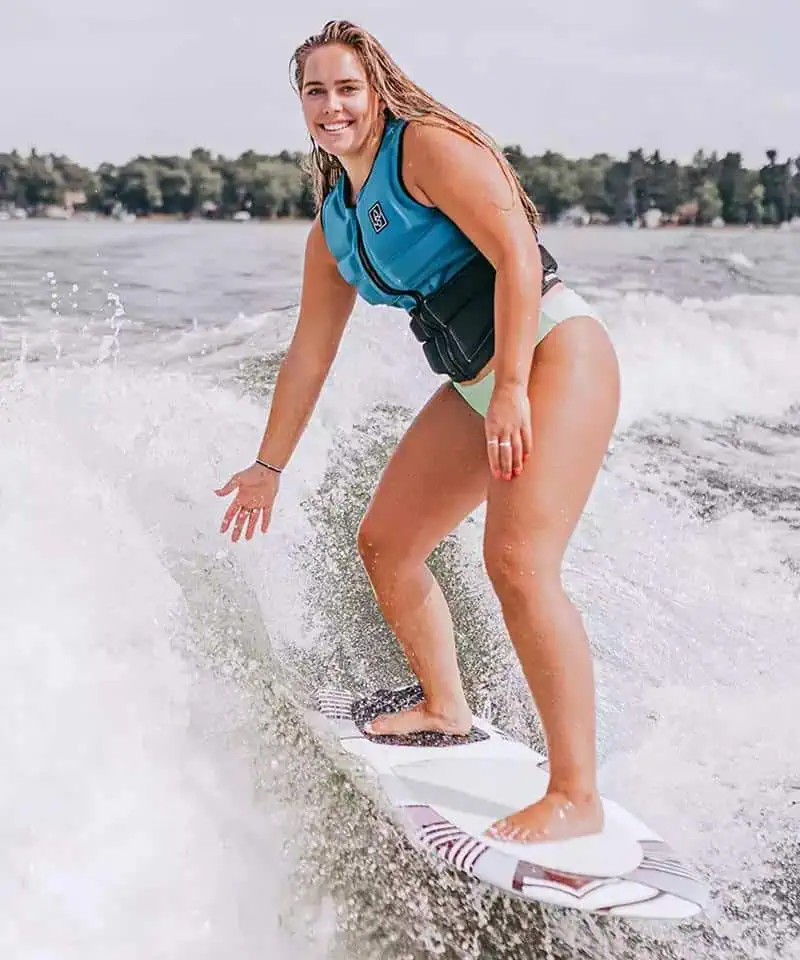
Boating Safety Tips Related to Wakesurfing Towing
Safe Distances and Speed
Maintaining safe distances from other boats, structures, and the shore is critical for wakesurfing. The ideal towing speed for wakesurfing is around 10-12 mph. This speed allows the boat to create a large, surfable wake without going so fast that the surfer loses control. Additionally, boats should always maintain a distance of at least 200 feet from the shoreline or other boats to minimize the risk of collisions or interference.
Propeller Safety
One of the main reasons inboard boats and wake boats are preferred for wakesurfing is the propeller’s placement. Since the propeller is underneath the hull, far from the surfer, the risk of injury is significantly reduced. In contrast, outboard and stern-drive boats have their propellers directly behind the boat, making them hazardous for wakesurfers who ride close to the stern.
Weight Distribution & Ballast Control
Ballast systems are essential for creating the right wave for wakesurfing. However, improper ballast use can make the boat unstable, leading to dangerous situations like capsizing or swamping. Always ensure the ballast is distributed evenly and that the boat isn’t overloaded beyond its capacity. It’s also essential to adjust the ballast based on the number of passengers and their placement in the boat to maintain balance and stability.
Legal Guidelines and Regulations
Different states and countries have specific laws about wakesurfing, particularly regarding distance from shorelines and other boats. It’s essential to familiarize yourself with local regulations before hitting the water. Some areas also have environmental restrictions that prevent large wakes near shorelines to avoid erosion or disturbance to wildlife.
Wakesurfing Etiquette
Following wakesurfing etiquette ensures safety for everyone on the water. Always yield to other boats and surfers, and never surf too close to other watercraft. Avoid busy areas and make sure you’re not disrupting swimmers or fishermen. A courteous wakesurfer is safer and helps maintain a positive reputation for the sport.
Boat Maintenance for Wakesurfing
Regular Engine Checks
Towing a wakesurfer requires the boat to work hard, so keeping the engine in peak condition is essential. Regular oil changes, fuel system checks, and engine inspections will help prevent breakdowns or accidents while on the water.
Wake Control Systems
Ensuring these systems are well-maintained if your boat comes with wake-shaping technology. Keeping the ballast system clean and functional is vital to generating the waves you need for wakesurfing.
Hull Cleaning and Care
A dirty or damaged hull can impact the boat’s performance, reducing its ability to create a proper wake. Regularly cleaning and inspecting the hull for damage will help maintain the boat’s efficiency and safety.
The Future of Wakesurfing Boats
Technological Advancements
Wakesurfing boats continue evolving, with manufacturers developing more intelligent and efficient wake control systems. GPS-based systems that automatically adjust ballast and wake shape based on the rider’s preferences are becoming more common, making the sport accessible to riders of all skill levels.
Hybrid and Electric Boats
With rising environmental concerns, some manufacturers are working on hybrid and fully electric boats. These boats could provide an eco-friendly alternative to traditional gas-powered wake boats, offering quieter operation and lower emissions while still producing high-quality wakes.
FAQs
Is wakesurfing easier than wakeboarding?
Wakesurfing is generally easier than wakeboarding for most people due to several key differences in technique and equipment. In wakesurfing, the rider is not strapped to the board, which provides more freedom of movement and makes it easier to balance.
The soft, consistent wake created by the boat allows the rider to find a stable “sweet spot” on the wave, making it easier to ride without relying on a tow rope once the wave is found. This means less strain on the body than wakeboarding, where the rider must stay attached to the tow rope for balance and propulsion throughout the ride.
Another reason wakesurfing is often considered easier is the slower speed at which the boat travels. Wakesurfing boats typically operate at around 10-12 mph, creating a more controlled and forgiving wave for the rider to surf. In contrast, wakeboarding usually requires speeds of 18-24 mph, which can be intimidating for beginners and results in more brutal falls when the rider loses balance.
The slower speed of wakesurfing makes it easier to control the board and reduces the physical impact of wipeouts, making it less physically demanding overall.
Finally, the riding stance and techniques differ between the two sports. Wakesurfing adopts a stance similar to traditional surfing, where balance and subtle shifts in weight control the board. This is a more intuitive motion for many beginners than wakeboarding, where the rider is pulled at higher speeds and must deal with the tension of the tow rope.
Additionally, wakeboarding requires more upper body strength to maintain control while holding the rope, while wakesurfing relies more on lower body and core strength, making it less strenuous and easier to pick up for most people.
How hard is it to master wakesurfing?
Wakesurfing is an intermediate to advanced water sport. It requires significant practice and skill development to master.
Is wake surfing safe?
Wake surfing is generally safe with the right equipment and precautions. Always wear a life jacket and avoid wake surfing in areas with heavy boat traffic.
Do you need a particular boat for wakesurfing?
While it is true that you don’t necessarily need a specially designed boat for wakesurfing, the type of boat you use can significantly impact both your safety and the quality of your wakesurfing experience. Standard inboard or sterndrive boats can be modified to create a sufficient wake, but there are essential factors to consider when using these boats for wakesurfing.
One of the most crucial considerations is the placement of the propeller. Inboard boats, where the propeller is located underneath the hull, are much safer than outboard or sterndrive boats, where the propeller sits behind the boat. This is why wakesurfers should avoid boats with exposed rear propellers, as these pose a significant injury risk.
That being said, many inboard boats can be enhanced with ballast systems to create a larger and better-shaped wake for wakesurfing. Adding aftermarket ballast bags to weigh the boat down helps increase the water displacement, generating a bigger wave.
While this setup can work well, it won’t always match the performance of boats designed explicitly for wakesports. Purpose-built wake boats come with integrated ballast systems, surf gates, and other technology designed to create the perfect wake with minimal effort.
For casual wakesurfers, modifying an inboard boat might be enough. Still, those serious about the sport often find investing in a wake-specific boat worthwhile for optimal performance.
Another point is the wave-shaping technology available on specialized wake boats versus standard inboard or sterndrive boats. Wake boats often feature advanced systems that allow for on-the-fly adjustments to the size and shape of the wake.
This level of customization provides a better experience for wakesurfers of all skill levels. In comparison, standard inboard boats may require more manual adjustments or additional weight distribution to achieve a similar effect, making it more time-consuming and potentially less consistent.
While a particular boat isn’t an absolute requirement for wakesurfing, using a purpose-built wake boat offers significant advantages in terms of safety, wave quality, and convenience. If you’re new to the sport or only plan to wakesurf occasionally, modifying a standard inboard boat could suffice.
However, for those passionate about wakesurfing and who want the best experience on the water, investing in a specialized wake boat will provide better performance, more control, and a safer environment for the surfer.
Summary
Choosing the right boat for wakesurfing is a crucial decision that impacts the quality of your ride and your safety on the water. While wake and surf boats offer the best experience with advanced wave control and safety features, inboard boats can also provide a solid option for those looking for a more affordable solution.
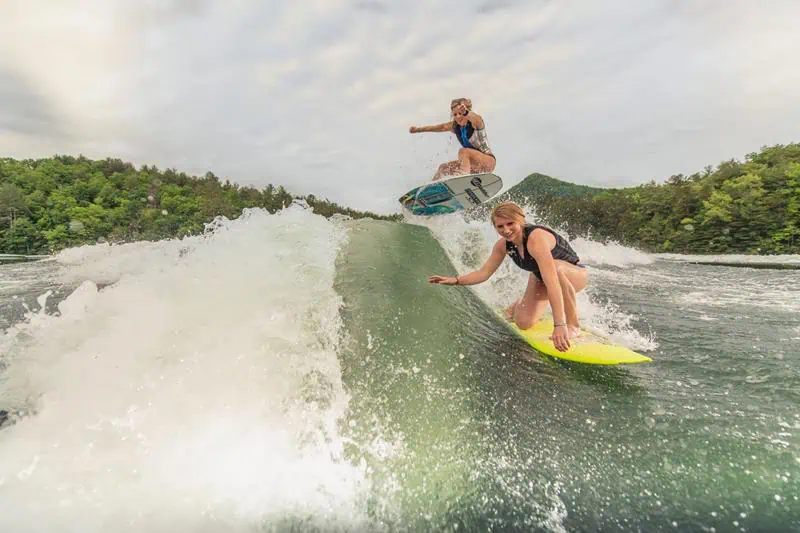
On the other hand, outboard boats and personal watercraft are not recommended due to safety risks and poor wave quality. No matter which boat you choose, always prioritize safety and maintenance to ensure a fun, injury-free wakesurfing experience. As technology advances, we can expect even more exciting developments in the world of wakesurfing boats, making the sport more accessible and eco-friendlier for future generations.

